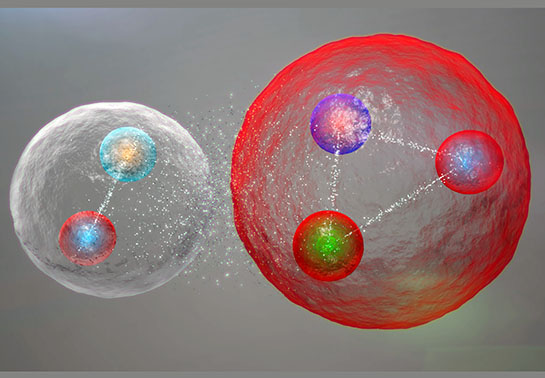
The 'Instituto de Física Corpuscular' coordinates one of the work areas of
STRONG-2020, a four-year European project, funded with 10 million euros,
which involves researchers from 36 countries and that begins to run in
the middle of this year.
The strong interaction is the most intense of the four forces that govern the relationships between the particles that build up everything we see in the Universe. It is responsible for protons and neutrons to stay together forming the atomic nucleus, which allows the existence of the matter from which we are made. To advance in their study, research groups from 36 countries participate in the project STRONG-2020, within the framework programme of research of the European Commission, Horizonte 2020. The 'Instituto de Física Corpuscular' (IFIC), mixed centre of the Universitat de València and the CSIC, participates in several research lines of the project and coordinates a working group dedicated to detailed studies of certain aspects of the interaction between hadrons.
Specifically, Juan Miguel Nieves Pamplona, scientific researcher of the CSIC at the IFIC, coordinates a working group focused on studies about the properties of the interaction and structure of hadrons (subatomic particles composed by quarks, the ‘bricks’ of visible matter). One of his objectives is the study of ‘exotic’ states, such as the pentaquarks observed in the LHCb experiment at CERN, to build a scheme that describes them better than the current model of constituent quarks. “Our intention is to study different structures within QCD, the theory that describes the strong interaction to, through effective theories and simulations in the reticulum, being able to describe better the alluvium of exotic states that we observe in the experiments”, Nieves explains.
These works aim to establish a theoretical framework to describe the interactions between hadrons in a regime where non-perturbative effects of QCD turn out to be relevant, according to the IFIC researcher. In addition, they are basic studies to determine fundamental parameters in Physics such as ‘CP violation’, the differences between matter and antimatter in particles affected by the strong interaction. On the other hand, much of the physics based on another fundamental interaction, the electroweak, depends on the deep knowledge of the strong force, which affects phenomena such as the oscillations of the neutrinos or the possible violation of the lepton universality, one of the most interesting recent results that points to the existence of ‘new physics’.
Theoretical and experimental studies of the strong interaction, one of the bases of the Standard Model of Particle Physics –a theory that describes the elemental particles and their interactions- attract a large community of 2,500 researchers in Europe. The STRONG-2020 project, a European Integrated Activity for Advanced Communities of four years recently approved by the European Commission within the Research and Innovation Horizonte 2020 programme, is a structured action to address the open questions in the studies on strong interaction, from the experimental and theoretical point of view. Endowed with 10 million euros, STRONG-2020 will begin to develop in mid-2019.
STRONG-2020 is supported by NuPECC (The Nuclear Physics European Collaboration Committee) and brings together many of Europa’s leading research groups and laboratories at the forefront of strong interaction research. It provides transnational access to six word-class research infrastructures in Europe (COSY, MAMI, LNF-INFN, ELSA, GSI, CERN) whose particle beams complement each other, as well as virtual access to open sources, automated and simulation tools. STRONG-2020 promotes synergies between theoretical and experimental physicists by supporting activities carried out at the European Centre for Theorical Studies in Nuclear Physics and Related Areas (ECT, Trento, Italy)
The STRONG-2020 Consortium includes 44 participating institutions from 14 European Union states, including Spain, an international organization (CERN) and a candidate for EU membership (Montenegro). On the Spanish side, in addition to IFIC, the Instituto Galego de Física de Altas Enerxías (IGFAE)- a mixed institute of the University of Santiago de Compostela and the Xunta de Galicia-and the Complutense (UCM) and Autonomous Universities of Madrid (UAM), Salamanca (USAL) and the País Vasco (UPV/EHU) participate.
In total, together with other institutions from 21 countries participating in the activities, STRONG-2020 involves researchers in 36 countries. The project is structured into 32 work areas comprising several themes: Project Coordination and Management, Dissemination and Communication, 7 Transnational Access Activities, 2 Virtual Access Activities, 7 Network Activities and 14 Joint Research Activities.
The results of STRONG-2020 will have an important impact on the study of strong interaction and the Standard Model. The project will also contribute to fundamental research in physics beyond the Standard Model, with repercussions in other fields such as astrophysics, strongly coupled complex systems theories and condensed matter studies. The tools and methods to be used in the cutting-edge experiments to be carried out within STRONG-2020 will allow European research infrastructures to be upgraded, thus improving their competitiveness. The technologies developed will also have an impact on medicine (diagnostic tools, cancer treatment) and industry (scanning cameras, 3D magnetic technology), and may also lead to advances in computing and machine learning.
In addition, STRONG-2020 will promote training activities, including doctoral and post-doctoral students. This will allow the access of qualified personnel to the labor market, as well as the realization of outreach activities.
Links:
















